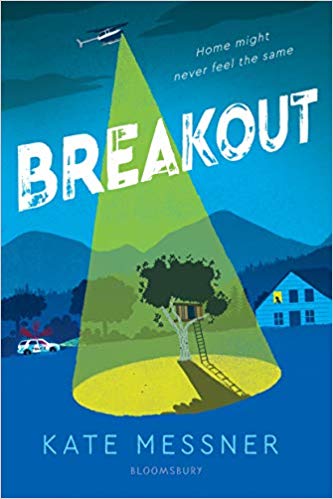Breakout (Hint: It’s not a story about pimples!)
One of the most unusual parts about Kate Messner’s Breakout, (Bloomsbury) is its format. The story is an epistolary novel — a story told in personal letters that characters exchange. In this case “letters” include text messages, excerpts from journals, transcribed audio recordings, and comics drawn by the main character’s little brother, Owen. Visually it’s a fun way to tell a story because the designer included very lifelike post-it™ notes with their corners bent, coffee stains, scotch tape and pages torn from spiral notebooks.
As the book begins we learn that students going into eighth grade next fall have to contribute five items to the town’s time capsule, to be opened in 50 years. The main character, Nora Tucker, wants to be a journalist, so she is excited about the project.
Everything changes when two convicted killers (one white, one black) escape from the local prison. The maximum-security prison is the town’s main employer. Nora’s father is the superintendent. The town is locked down. Reporters swarm the community. Nora is thrilled to meet her hero, a female reporter from CNN. But then, when that reporter reports things Nora told her during a friendly chat, Nora learns “sometimes there’s a fine line between being a journalist and being a jerk.”
Messner also tackles race in a nuanced way. One way she does that is through Elidee, a character who just moved to school as the story begins. Elidee has dreams of going to a prestigious private school in New York. When she is rejected, her mom decides to move them to Wolf Creek to be closer to her older brother, who is an inmate. Elidee helps us see the situation from the perspective of an outsider and the kinds of assumptions and judgements people make based on skin color.
Nora has her eyes opened, not just about journalists but about the inmates. Wolf Creek is almost entirely white and so it’s not too surprising that most of the prison employees are white, but when Nora’s big brother, Sean, points out that 75% of the inmates are non-white, meaning either black or Latino, their father gets defensive and the dinner discussion gets tense.
Later, Nora’s best friend Lizzie reflects on what they learned: “I had no idea it was like that. And if Sean is right and it’s because of racist policies and stuff, that’s pretty messed up.”
As we can see from Nora, Lizzie and Elidee’s contributions to the time capsule, these girls all learned and grew, which makes this a very satisfying story.



0 Comments